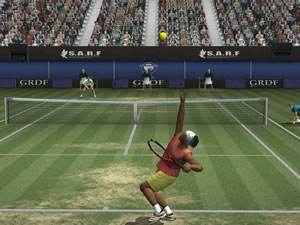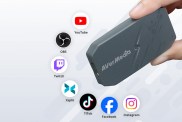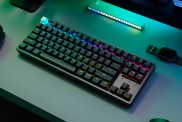A passing shot.
You’d be hard pressed to come up with a game as elegantly designed as tennis. The rules are unbelievably simple: hit the ball over the net, keep it in bounds, and don’t let it bounce more than once. Aside from that, there isn’t really much to learn, unless you count the ridiculous scoring system.
But when it comes to video games, simplicity isn’t always the best way to go. Sports games oozing with intricate depth, such as football or baseball, tend to have a longer shelf life than tennis. Lucky for net fans, Namco is undaunted by the fact that there hasn’t been a new tennis game for the PS2 in years and comes out swinging with Smash
Court Tennis Pro Tournament 2, the sequel to its mediocre first effort. And just like a Williams sister, the game has gotten better with age, though is still far from the glory it hopes to one day achieve.
Before Smash
Court hoists the tennis video game trophy, it will have to get past
the reigning champ, Sega’s Virtual
Tennis series. The two games have much in common, mainly because Smash
Court borrowed liberally from Sega
Sports Tennis to
begin with.
Things have changed a bit with the sequel, particularly in its emphasis on hit
timing. Rather than holding down a button to charge up a shot, the onus is
on the player to press the button right when the ball is hitting the racket
face for maximum power and accuracy. It’s a fairly small window, which gives
the game a steeper learning curve than most tennis games and gives Smash
Court a notably different feel than the game on which it is clearly
based.
Otherwise, the control is pretty standard. You can hit slices, lobs, topspins
and flat shots at will, though the timing can have dire consequences on the
result. This is especially true with the flats shots, which have a tendency
to sail out of bounds unless you time it right. You’ll wind up using the topspin
and slice shots for a while until you start to get the timing down. While at
first it’s a little frustrating, the gameplay system gets better as you get
better, leading to a satisfying challenge.
The game features plenty of modes. A decent Tutorial helps teach you the
system and a somewhat useless Spectator mode will appeal to your voyeuristic
tendencies. Those with less patience can hop right onto the court in Arcade
or Exhibition mode, both of which allow you to play as or against any of the
game’s
licensed pro players on a multitude of real-world courts. Most contemporary
big name male and female tennis players are here, from Roddick, Henman, Safin
and Hewitt to Davenport, Clijsters, Henin-Hardenne and, of course, Anna “Maybe
One Day I’ll Actually
Learn How To Play Tennis” Kournikova. Sigh.
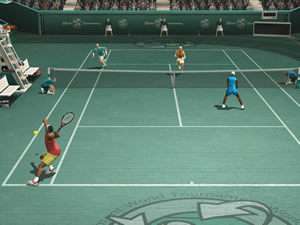 The depth of Smash
The depth of Smash
Court can be found in the Pro Tournament mode, in which you build
you own player and take him or her through a full career. The creator is very
basic, hardly touching the likes of Top
Spin for the Xbox, but things get better
in terms of statistics. As you play through tournaments and training exercises,
you’ll gain experience to divvy out to elements like Power and Stamina as well as cash to spend on a pretty thin collection of gear, some of which can enhance your performance. It takes a good amount of playing to really get going, but over time you’ll notice that you’re moving faster, hitting harder and just playing better as you climb in the rankings.
The most interesting thing about Pro Tournament mode is its default Mission system. Rather than have you slog through 5 sets of 6 games apiece just to get out of the first round in some Podunk tournament, Smash
Court simulates the match up to a “Turning Point” in each set, then plops you into the action with a specific mission to complete. These range from the simple (acing one serve) to the obtuse (prevent your opponent from hitting more than 40% backhands), and if you complete them will net additional experience and often win the set outright.
It’s a good idea, but can turn frustrating in a jiffy. Some missions aren’t optional – if you don’t fulfill the requirements you’ll annoyingly lose the game, which can ruin a perfectly good run through a tournament. For instance, one mission might start you up 30/Love and ask to close out your opponent, meaning you have to win two straight points or you lose. Since you don’t determine which missions pop up, you can easily find yourself up against tough odds by no fault of your own.
Luckily, you can choose to disable the entire Mission system altogether before entering a tournament, in which case you simply play one set against each opponent without any additional requirements. You’ll miss out on the additional XP, but will also miss out on the irritating lack of control over the matches.
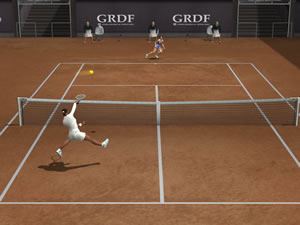 Whether
Whether
playing in a low level tournament or at the hallowed grounds of Wimbledon, Smash
Court looks pretty good thanks in no small part to a rock solid framerate
and nice, clean visuals. The various court surfaces are realistic ” footprints
and ball marks give some punch to the clay courts in particular. The player animations
are fluid and they are far less prone to diving at balls like in Sega
Sports Tennis.
Player models, however, are often generic and sometimes don’t even vaguely match
the name or country of origin. I’m pretty sure Wai Tsang representing China shouldn’t
have red hair and white skin.
Sadly, the game misses out on some basic features, like any sort of user-controlled replay system to check out great shots from various angles. Speaking of which, you get a measly two camera angles from the start, and you’ll get more only after winning Grand Slam events, if you can believe that. And considering the success of Top
Spin‘s Xbox Live play and the evolution of PS2 online play since Sega
Sports Tennis came out two years ago, it’s a shame that Smash
Court doesn’t support any online features whatsoever.
But these aren’t deal breakers, and considering the paltry number of offerings out there right now, it’s about as good as tennis gets on the PS2. Net fans should feel confident in Smash
Court Tennis Pro Tournament 2‘s ability to deliver a solid match.
-
Good mechanics
-
Solid graphics
-
Decent Pro Tournament mode
-
With annoying missions
-
Weak customization
-
No online play
